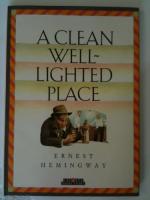|
This section contains 6,685 words (approx. 23 pages at 300 words per page) |

|
SOURCE: “‘A Clean, Well-Lighted Place’: Interpreting the Original Text,” in The Hemingway Review, Vol. II, No. 2, Spring, 1983, pp. 32-43.
In the following essay, Thomson examines the controversy surrounding the waiters' dialogue regarding the soldier and the girl.
I. the Nature of the Textual Problem
Hemingway's story begins late at night in a café. An old man is drinking, watched by two waiters who are not differentiated. In Dialogue 1, comprising seven speeches, there is no way of knowing who begins the exchange, hence no way of knowing which waiter refers to the old man's attempted suicide and which asks questions about it. In Dialogue 2, comprising three speeches, there is similar indefiniteness. Only when the old man asks for another drink does the reader learn that one of the waiters is “younger,” is sleepy, and never gets to bed before three o'clock. Even at the beginning of Dialogue 3—I have...
|
This section contains 6,685 words (approx. 23 pages at 300 words per page) |

|


